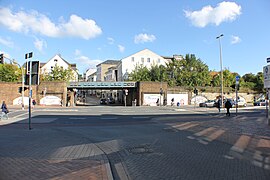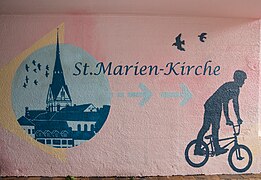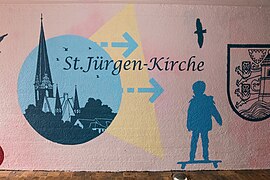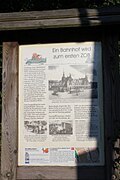Flensburg harbor railway
| Flensburg harbor railway | |||||||||||||||||||||||||||||||||||||||||||||||||||||||||||||||||||||||||||||||||
|---|---|---|---|---|---|---|---|---|---|---|---|---|---|---|---|---|---|---|---|---|---|---|---|---|---|---|---|---|---|---|---|---|---|---|---|---|---|---|---|---|---|---|---|---|---|---|---|---|---|---|---|---|---|---|---|---|---|---|---|---|---|---|---|---|---|---|---|---|---|---|---|---|---|---|---|---|---|---|---|---|---|
|
Tram-like section in the center
| |||||||||||||||||||||||||||||||||||||||||||||||||||||||||||||||||||||||||||||||||
| Route number (DB) : | 1003, 1002 (east side) | ||||||||||||||||||||||||||||||||||||||||||||||||||||||||||||||||||||||||||||||||
| Gauge : | 1435 mm ( standard gauge ) | ||||||||||||||||||||||||||||||||||||||||||||||||||||||||||||||||||||||||||||||||
|
|||||||||||||||||||||||||||||||||||||||||||||||||||||||||||||||||||||||||||||||||
The Flensburg Port Railway is a 4.5 km long, standard-gauge railway line that branches off the Neumünster – Flensburg railway line and opens up downtown Flensburg and the west bank of the Flensburg Fjord . There is also a track on the east bank that has been partially dismantled. It is one of the few German port railways on the Baltic Sea .
background
The port railway line has existed since 1854 and is the oldest still preserved railway line in Germany. It was an important part of the largest Flensburg harbor festival , the steam all around . On November 6, 2014, large parts of the western route were made unusable by asphalting. This measure should be removable. The plant's existence is at great risk.
Route description
The Flensburg Port Railway begins two kilometers north of the Flensburg-Weiche station at the Wilhelminental alternative junction , where it meets the feeder line to Flensburg station on the one hand and the Flensburg-Neumünster railway line on the other.
In order to be able to drive from the station to the port railway, a saw drive is necessary. From the Flensburg Weiche station , the port railway can be used without changing direction . The switch at the junction has been expanded since September 2015. The port railway, which was shut down in 2014, has no longer been able to be used.
From Wilhelminental the route runs 2.4 kilometers north over a railway embankment through the city center towards Flensburg Fjord. The embankment runs along the original waterfront of the fjord and the Mühlenstrom, its mass protects the Johannisviertel , which is not far from the fjord, from the traffic noise of the main road on the other side and thus marks the original border of the fishing peninsula .
When the railway line was laid, a location not far south of the Hafenspitze in the area of today's main road was chosen for the Flensburg train station. The first station, called Englischer Bahnhof , was later replaced by the Prussian station , which was located in the same place. This station was the most important Flensburg station until the 1920s. After the construction of the new station, it was rededicated as the first German bus station.
The track systems for boarding rail travelers were dismantled. At Hafenspitze, Angelburger Strasse , Heinrichstrasse and Bahnhofstrasse, the route runs over railway bridges. Important connecting roads run under these.
To the north of the bus station, the actual port railway to connect the Flensburg port and some businesses begins . The western route runs northwards directly on the fjord. It is partly laid out like a tram and connects the Flensburger Stadtwerke and the shipyard of the Flensburger Schiffbau-Gesellschaft .
The stretch on the east bank, which led to the industrial port and into the military area at the Naval School Mürwik , was partially dismantled. The stretch on the east bank is partly overgrown with plants and extends all the way to Lautrupsbach , where the controversial Klarschiff building was built between 2012 and 2013 .
Operation and history
The first Flensburg port railway was built by the company Peto, Brassey and Betts by October 25, 1854 , in order to be able to load cattle landed in Flensburg onto the railroad on the newly built Flensburg – Husum – Tönning line for shipment to Great Britain.
The port railway was built in 1854 up to today's sailing port and extended to the shipyard with the establishment of further industrial operations in the north of Flensburg. From the first station there was a loading platform on the 257 m long Englische Brücke , built in 1857, which was initially used to transfer cattle between rail and ship.
At the southern end of the Flensburg Fjord, the terminus of the line to Tönning, known as the English station , was built . Its station building was rebuilt in a representative style by Johannes Otzen in 1883 (Prussian train station).
Since 1928, after the construction of today's train station in the south of the city, this track system was only used as a freight station. In 1929 the bridge girders of the railway bridge at Angelburger Strasse were renewed. The retaining wall of the railway embankment there was built from yellow bricks at the same time, in keeping with homeland security architecture . On December 31, 1931, the Prussian railway station was rededicated as the first bus station in Germany. Around 1935, the feed route to the port was relocated to a dam to the east of this bus station.
Regular freight traffic took place on the route until the 1990s. After that, the route was only used for special trains, for example to transport passengers to and from special trips on the originally preserved saloon steamer Alexandra, built in 1908 , or to bring Bundeswehr vehicles to the FFG on the west bank for maintenance .
On certain occasions, such as the special event Dampf Rundum in Flensburg, special traffic was operated on the route, for example from the Angelner steam train .
On November 6, 2014, rails were filled with asphalt on the west side. This means that large parts of the west side are no longer passable. This measure should be removable. The continued existence of the plant has been questioned by parts of the politicians. The proposed dismantling of the stabling options on the east bank is likely to further limit the possibility of use.
perspective
There are considerations - suggested among others by the passenger association Pro Bahn - to build a new passenger station at the level of the central bus station (ZOB) . The central location at the central bus station is seen as an advantage in these proposals and it is assumed that this will increase the number of passengers. In 2015, an expert opinion on the possible further development of rail traffic in Flensburg was published, which took a closer look at various options submitted by the city. Of four feasible planned cases, one contained the combination of a large long-distance train station in Weiche and a smaller station at the ZOB. Depending on the degree of expansion, costs of between 28 and 59 million euros were forecast. In November 2016, the decision was made to keep the station at its current location. The majority of the City Council of Flensburg decided to implement a long-discussed cycle path on the railway line.
The state of Schleswig-Holstein refused to approve the request of the city of Flensburg to dismantle the route at the end of 2018. In 2019, structural components of the port railway were registered in Schleswig-Holstein's monument book for historical, artistic, urban planning and technical reasons. In this context, the railway bridges and the retaining masonry of the railway embankment were explicitly mentioned. In March 2020, the responsible Higher Administrative Court decided that the tracks and areas of the actual port railway on the west and east banks north of the central bus station are the city's planning sovereignty. Contrary to the ideas put forward by the NEG Niebüll , possible regional traffic in the future must definitely end at the central bus station. However, because the embankment to the port is not being dismantled, the cycle path cannot be built at the moment.
The Flensburg embankment with the St. Johanniskirche
View of the railway embankment from the western Angelburger Strasse
Tracks on the east bank at the fishing museum (2014)
A trolley as a suggestion of the Stadtdenkerei project to reactivate the system
mouse hole
The mousehole ( low German Muusloch , Danish Musehullet , location ) is a known pedestrian underpass near the Flensburg ZOB , which passes through the railway embankment of the Flensburg port railway. When exactly the mouse hole was created is unclear, possibly around 1929, when the yellow brick retaining wall was also created. It can already be found in the city model in the Flensburg town hall , which depicts Flensburg around 1950.
It is also unclear since when the mouse hole got its popular name. Due to its smaller size, the centrally located mousehole, like many other underpasses, is usually not shown on city maps. The mouse hole has a length of about 17 to 18 meters from the tunnel opening to the end of the tunnel. The opening on the west side is approximately 2.45 meters high and 2.50 meters wide. On the east side, the opening has a height of about 2.65 meters and is also 2.50 meters wide.
The mouse hole connects the footpath of the Süderhofenden street, where the central bus station is located, with the Johannisviertel to the east . The parking spaces at the eastern tunnel opening are located on an area that has been reserved for a possible second, central Flensburg train station (or stop ). Since the central bus station used to be on the street side with the mouse hole, today there is a board at the mouse hole after the renovation that deals with the history of the central bus station.
Around 2000 the artist Daniel Heger provided the mouse hole with matching graffiti . Since then, gray-colored mice have been waiting for visitors above the tunnel openings. The tunnel itself had been designed by him as a giant cheese. There was another particularly large mouse in the tunnel. Despite the loving design, the commissioned work of art suffered from vandalism inside the tunnel .
From 2013 to 2014 politicians wanted to create a separate cycle path in the Flensburg town hall on Heinrichstraße, for which they wanted a second mouse hole. The second tunnel through the embankment, discussed for months, would have cost 750,000 euros. The Flensburg politicians waived the measure and closed part of the lane especially for cyclists and pedestrians. Alternatively, the pedestrians would still have to switch to the other side of the street. The cyclists should have done this too or should have used the lane.
In June 2017, the graffiti artist Sven Schmidt from the graffiti painters, who have already carried out various works in Flensburg, designed the tunnel in new, lighter colors. The work was initiated and financed by the Eastern Old Town Action Group. The transport company Aktivbus Flensburg also participated in the financing . On the “pink chewing gum” background, the lettering “Mauseloch” is now emblazoned at the western and eastern entrances with identical, monochrome mice that were inserted using stencil technology. The use of such templates offers the possibility of restoring work in the event of vandalism much more easily. In contrast to the previous work, the mouse hole theme was left out inside the tunnel. Instead, landmarks and sights of the city as well as people walking by were selected as motifs for the commissioned work, which were also designed as monochrome silhouettes in pastel shades. The non-local tourist is shown the direction to these attractions by the attached arrows. Approximately in the middle of the tunnel there are identical, black-colored Flensburg coats of arms on both sides of the tunnel . An individually designed mouse was attached near the floor of the two exits .
literature
- Holger Kaufhold, Eckhard Klein, Detlef Schikorr: 150 Years of the Railway in Flensburg - From the Southern Schleswig Railway to the Deutsche Bahn AG. (= Series of publications by the Society for Flensburg City History. Volume 58; = LOK Report ). Sigmaringen 2004, ISBN 3-935909-22-5 .
- Flensburg - history of a border town. (= Series of publications by the Society for Flensburg City History ). Flensburg 1966, OCLC 7708644 .
- Erich Keyser (Ed.): German city book. Urban History Handbook. Volume I: Northeast Germany . On behalf of the Conference of the Regional History Commissions of Germany with the support of the German Municipal Association. Stuttgart 1939, DNB 949515701 .
- Gert Uwe Detlefsen: Flensburg in old views . Zaltbommel 1984, ISBN 90-288-2718-8 .
- Dieter Pust : Flensburg A city and its history. Lübeck 2002, ISBN 3-87890-093-7 .
Web links
- Track plan of the old station in 1938
- Track plan port station 1980
- Probably the last train ride on the Flensburg Port Railway on July 14, 2013
Individual evidence
- ↑ Hans-E. Henningsen: Germany's oldest track system: Birthday greetings / Tillykke med dagen. In: Flensburg Journal. September 26, 2014, accessed September 30, 2014 .
- ↑ Holger Ohlsen: The port railway is disconnected. In: Flensburger Tageblatt. sh: z das Medienhaus, July 22, 2015, accessed on February 28, 2016 .
- ↑ Flensburger Tageblatt : Battle for the Ballastkai places from May 3, 2013; accessed on March 1, 2014.
- ^ Holger Kaufhold, Eckhard Klein, Detlef Schikorr: 150 Years of the Railway in Flensburg; From the Southern Schleswig Railway to the Bahn AG. Berlin 2004, ISBN 3-935909-22-5 , p. 16.
- ^ Lutz Wilde : Monument topography Federal Republic of Germany, cultural monuments in Schleswig-Holstein, Volume 2, Flensburg, p. 262.
- ↑ Pro rail concept for rail traffic around Flensburg. Retrieved September 8, 2019 .
- ↑ Gerhard Nowc: Bad user rate: who still takes the train in Flensburg? In: Flensburger Tageblatt. December 22, 2016, accessed May 2, 2018 .
- ↑ Expert opinion on the future rail structure in Flensburg , dated December 11, 2015; Retrieved on: May 3, 2018
- ^ Gertz Gutsche Rümenapp: Future railway structure in Flensburg. (PDF; 2.3 MB) City of Flensburg, September 25, 2015, accessed on May 2, 2018 .
- ^ Joachim Pohl: Flensburg: Majority relies on the existing train station. In: Flensburger Tageblatt. November 18, 2016, accessed May 2, 2018 .
- ↑ Gerhard Nowc: Flensburg Railway Network: No cycle path - the tracks remain. In: Flensburger Tageblatt. April 11, 2018, accessed May 2, 2018 .
- ↑ List of monuments Flensburg City of Flensburg (March 18, 2019)
- ↑ Julian Heldt: Defeat for NEG: the court confirms the planning authority of the city of Flensburg for railway tracks at the port. In: Flensburger Tageblatt. March 13, 2020, accessed March 17, 2020 .
- ^ Andreas Oeding, Broder Schwensen, Michael Sturm: Flexikon . 2009, article: Mauseloch und Marsch und Förde - Mauseloch , from: January 26th, 2004; accessed on: April 22, 2015.
- ^ Lutz Wilde : Monument topography Federal Republic of Germany, cultural monuments in Schleswig-Holstein, Volume 2, Flensburg, p. 262.
- ^ Andreas Oeding, Broder Schwensen, Michael Sturm: Flexikon . 2009, article: City model
- ↑ Flensburger Tageblatt : Regionalverkehr: New discussion about Zob train station , from: December 14th, 2013 as well as Flensburg town planning: Fight for the best city parking lot , from: January 16, 2014; Accessed on: April 22, 2015.
- ^ Andreas Oeding, Broder Schwensen, Michael Sturm: Flexikon . 2009, article: Mauseloch und Marsch und Förde - Mauseloch , from: January 26th, 2004; accessed on: April 22, 2015.
- ↑ Further works by the Berlin-born artist in Flensburg can still be found today on the small St. Jürgentreppe and on the neighboring house of the Eckener Haus in Neue Straße. See Art, The Sprayer Daniel Heger , from August 2004 and Graffiti - Art in Flensburg: Permanent Exhibition ( Memento from June 13, 2015 in the Internet Archive ), from: September 29, 2008; Accessed on: April 22, 2015.
- ^ Graffiti in Flensburg , accessed on: March 22, 2016.
- ↑ Cf. Flensburg traffic project: Second mouse hole in the railway embankment , dated: April 13, 2013, embankment plans: Tunnel dreams are buried , dated: February 8, 2014, It works without a tunnel , dated: September 25, 2014 and the cancellation of the Obligation to use: Flensburg lets cyclists on the road from: April 1st, 2015; Accessed on: April 22, 2015.
- ↑ a b Niels Ole Krogh: Se billederne: Musehullet er blevet tyggegummirosa. In: Flensborg Avis . June 29, 2017. Retrieved June 29, 2017 (Danish).
- ↑ See graffiti painter
- ↑ See the eastern old town of Flensburg
























